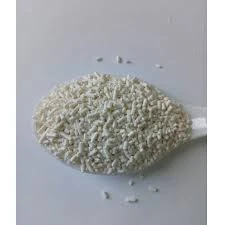
sodium dichloroisocyanurate
Understanding Sodium Dichloroisocyanurate Applications and Safety
Sodium dichloroisocyanurate, commonly referred to as NaDCC, is a white crystalline compound widely recognized for its powerful disinfecting and chlorinating properties. It is a derivative of isocyanuric acid and is often used in various applications, particularly in water treatment and sanitation. Its efficacy in eliminating pathogens makes it a vital component in public health and environmental safety.
Chemical Composition and Properties
Sodium dichloroisocyanurate has the chemical formula C3Cl2N3NaO3. It contains two chlorine atoms, making it a strong chlorinating agent. The compound is stable and can be stored without significant degradation over time, making it highly valuable in situations requiring long-term storage before use. The solubility of NaDCC in water enables it to be used effectively for disinfection purposes, as it releases chlorine when dissolved.
Applications in Water Treatment
One of the primary uses of sodium dichloroisocyanurate is in water treatment. Swimming pools, cooling towers, and drinking water facilities utilize NaDCC to control the levels of bacteria, viruses, and other harmful microorganisms. The compound is especially effective against pathogens such as E. coli and Legionella, which can cause serious health issues. When introduced into water, NaDCC disassociates to release chlorine, thereby disinfecting the water and ensuring its safety for various uses.
In swimming pools, maintaining proper chlorine levels is crucial for preventing infections and ensuring the safety of swimmers. Sodium dichloroisocyanurate is favored over traditional chlorine methods due to its ease of use and effectiveness. It is less harsh on skin and eyes compared to some other chlorine formulations, which enhances the swimming experience.
Sanitation and Hygiene
sodium dichloroisocyanurate

Outside of water treatment, NaDCC is employed in sanitation and hygiene applications across various industries. For example, healthcare facilities often use sodium dichloroisocyanurate for disinfecting surfaces and medical equipment. Its broad-spectrum antimicrobial activity makes it effective against a wide range of pathogens, including bacteria, viruses, and fungi, thereby reducing the risk of healthcare-associated infections.
In food production and processing, NaDCC is used to sanitize equipment, surfaces, and even as a rinse aid for fruits and vegetables. By ensuring that these items are free from harmful microorganisms, sodium dichloroisocyanurate plays a crucial role in food safety and public health.
Safety and Handling
While sodium dichloroisocyanurate is a vital tool in disinfection, it is essential to handle it with care. When using NaDCC, safety precautions should be observed, as it can be harmful if ingested, inhaled, or if it comes into contact with the skin. It is classified as a mild irritant to the eyes and skin, so appropriate protective gear, such as gloves and eye protection, should be employed during handling.
Storage of NaDCC should be in a cool, dry place, away from incompatible materials such as strong acids or reducing agents. Proper disposal methods must be adhered to, as improper disposal can lead to environmental contamination or the formation of hazardous byproducts.
Conclusion
Sodium dichloroisocyanurate represents a significant advancement in the field of disinfection and water treatment. Its effectiveness in eliminating harmful microorganisms has made it a staple in many industries, from public health to agriculture. Understanding the properties, applications, and safety measures associated with NaDCC is crucial for anyone involved in its use. As society continues to prioritize health and safety in various environments, sodium dichloroisocyanurate will undoubtedly remain a key player in the pursuit of cleanliness and sanitation.
-
Pure Sodium Dichloroisocyanurate Dihydrate | Powerful DisinfectantNewsAug.29,2025
-
Industrial Chemicals: Quality & Purity for Every IndustryNewsAug.28,2025
-
Nitrile Rubber Honoring Strict Production StandardsNewsAug.22,2025
-
Aspartame Ingredients Honoring Food Safety ValuesNewsAug.22,2025
-
Fertilizer for Balanced Plant NutritionNewsAug.22,2025
-
Cyanide Gold Processing with High Purity AdditivesNewsAug.22,2025
-
Formic Acid in Textile Dyeing ApplicationsNewsAug.22,2025
Hebei Tenger Chemical Technology Co., Ltd. focuses on the chemical industry and is committed to the export service of chemical raw materials.
-

view more DiethanolisopropanolamineIn the ever-growing field of chemical solutions, diethanolisopropanolamine (DEIPA) stands out as a versatile and important compound. Due to its unique chemical structure and properties, DEIPA is of interest to various industries including construction, personal care, and agriculture. -

view more TriisopropanolamineTriisopropanolamine (TIPA) alkanol amine substance, is a kind of alcohol amine compound with amino and alcohol hydroxyl, and because of its molecules contains both amino and hydroxyl. -

view more Tetramethyl Thiuram DisulfideTetramethyl thiuram disulfide, also known as TMTD, is a white to light-yellow powder with a distinct sulfur-like odor. It is soluble in organic solvents such as benzene, acetone, and ethyl acetate, making it highly versatile for use in different formulations. TMTD is known for its excellent vulcanization acceleration properties, which makes it a key ingredient in the production of rubber products. Additionally, it acts as an effective fungicide and bactericide, making it valuable in agricultural applications. Its high purity and stability ensure consistent performance, making it a preferred choice for manufacturers across various industries.





